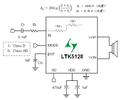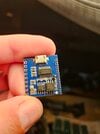Hello, I have a project in which I'd like to use the DY-SV19T to play mp3 files and also use an ESP32 to play tones through the same speaker. When I hook them both up to the same speaker the DY-SV19T plays fine but the ESP32 doesn't play the tone.
I found if I put a 10ohm resistor between the - of the speaker and the ground of the ESP32 they both play fine. But when the DY-SV19T plays an MP3 file the resistor gets very hot quickly. I put several resistors in parallel equalling 10ohms which slows down the heat, but this isn't an ideal solution.
I hoping to get some insight into this problem here. Any ideas as to what the cause of this is or potential solutions would be greatly appreciated.
I found if I put a 10ohm resistor between the - of the speaker and the ground of the ESP32 they both play fine. But when the DY-SV19T plays an MP3 file the resistor gets very hot quickly. I put several resistors in parallel equalling 10ohms which slows down the heat, but this isn't an ideal solution.
I hoping to get some insight into this problem here. Any ideas as to what the cause of this is or potential solutions would be greatly appreciated.





